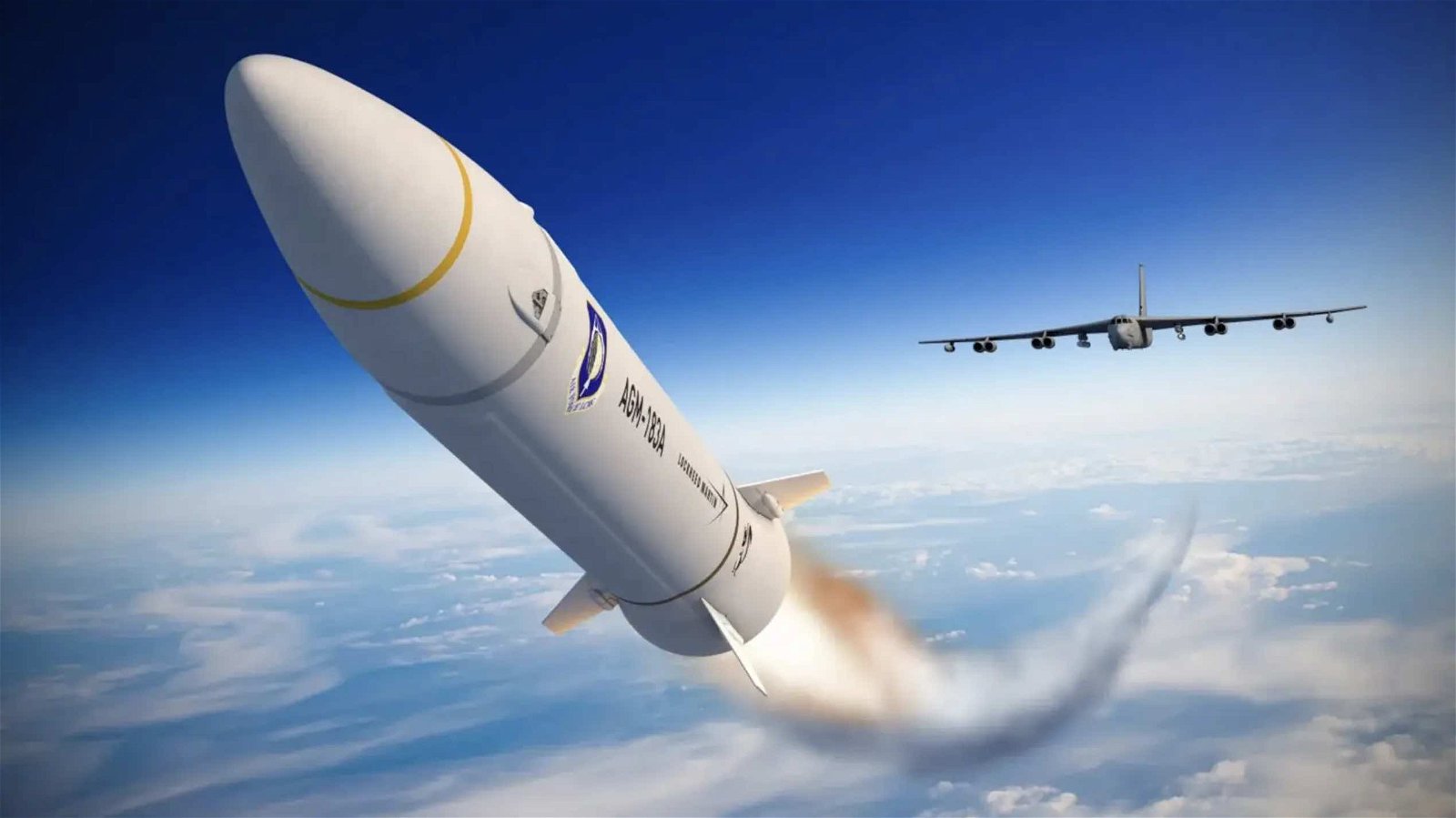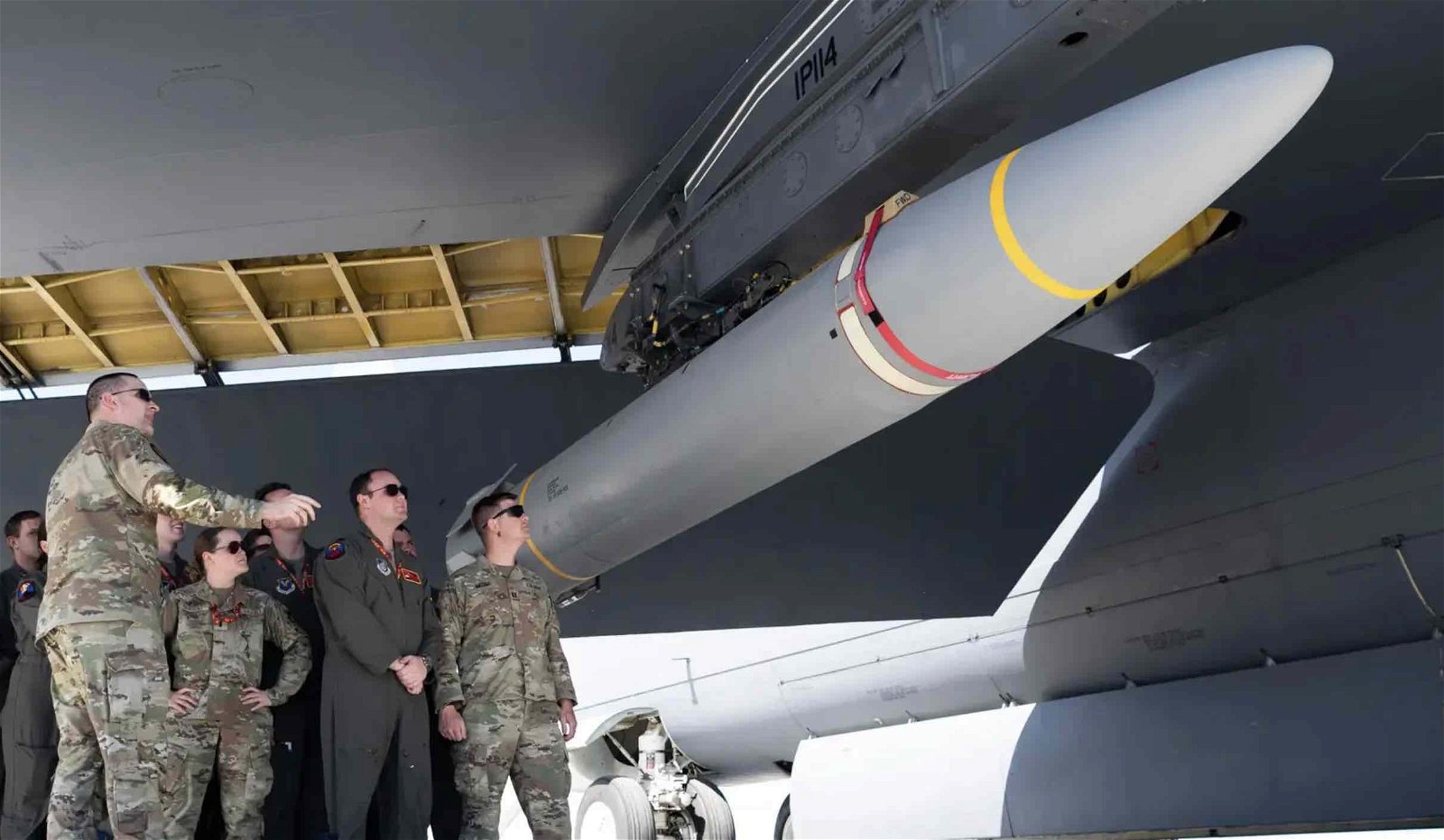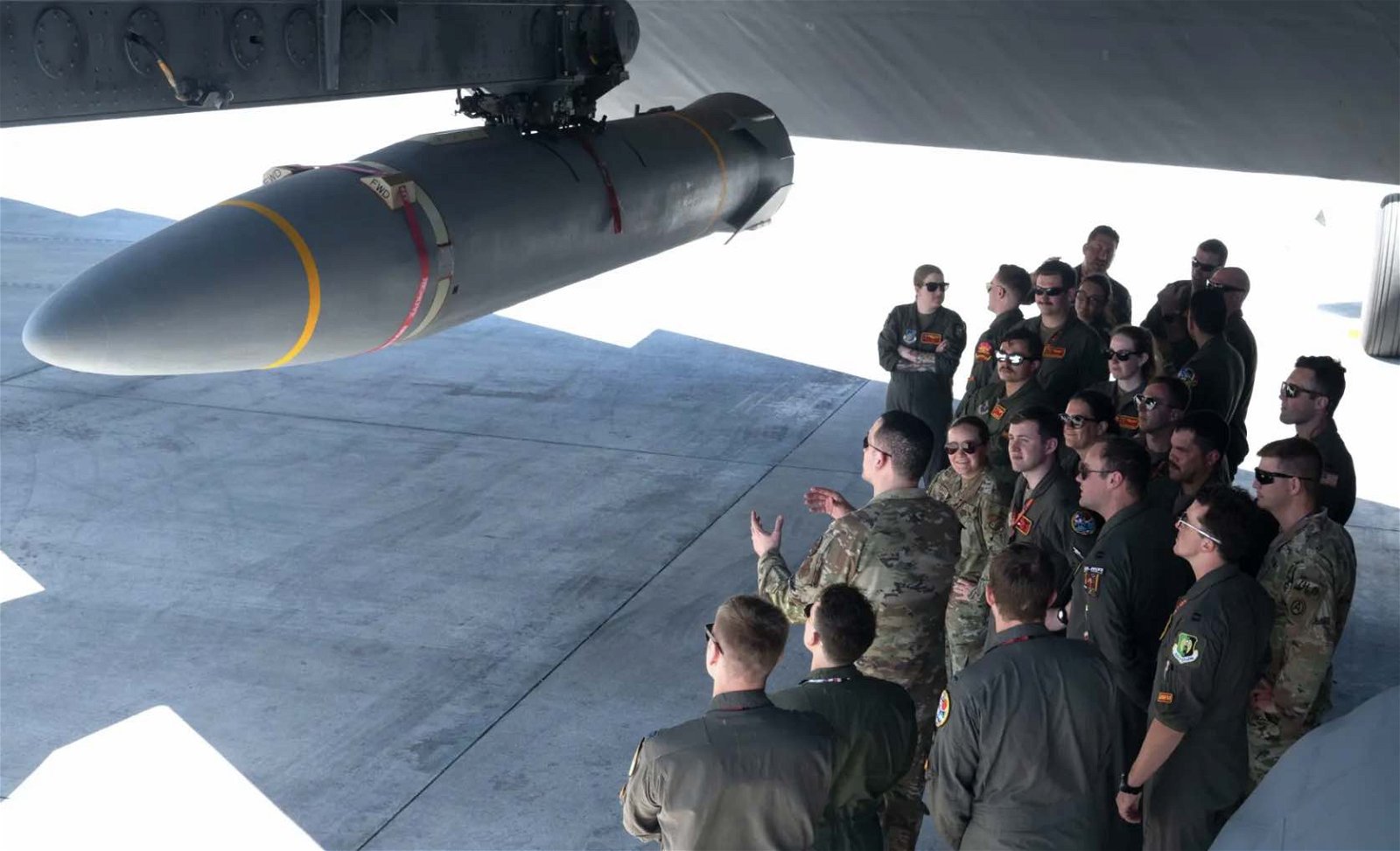

Welcome to this week’s Intelligence Brief… on Sunday, a hypersonic missile test conducted by the U.S. Air Force that many had speculated would soon be underway took place. In our analysis, we’ll be looking at 1) the recent successful test over the Marshall Islands, 2) what the USAF’s new AGM-183A hypersonic weapon is capable of, 3) how images that appeared online last month led to speculations about an imminent test involving the new weapon, and 4) why its arrival marks a pivotal moment as amidst similar developments by foreign nations.
Quote of the Week
“The Air Force gained valuable insights into the capabilities of this new, cutting-edge technology.”
– U.S. Air Force Statement issued following Sunday’s test.
Latest News: Recently at The Debrief, we reported that activists in New York are preparing to march for UAP transparency, and elsewhere, we look at a series of asteroids with strange “active” properties that have been detected, and what that could mean. All of our recent stories can be found at the end of this week’s newsletter.
Podcasts: In podcasts from The Debrief, on The Debrief Weekly Report, Kenna and Stephanie talk about new LSD policies that may alter how we deal with mental health in the future, and much more. Meanwhile, on The Micah Hanks Program, we take a deep dive into one of the most notorious incidents from the early Cold War era and look at what might really have happened. You can subscribe to all of The Debrief’s podcasts on our Podcasts Page.
Video News: On the latest installment of Rebelliously Curious, Chrissy Newton is joined by Agnieszka Pilat, a Polish-American artist and writer working at the intersection of robotics, Artificial Intelligence, and fine art. You can check out this interview, and other great content from The Debrief, on our official YouTube Channel.
With all the housekeeping out of the way, it’s time we take a look at the recent test of a hypersonic missile by the U.S. that occurred over the weekend.
The USAF Performs a Successful Hypersonic Test
It was learned this week that the United States Air Force (USAF) conducted tests with a prototype hypersonic missile in the Marshall Islands.
Providing few details about the drill, which occurred on Sunday, the USAF launched the missile from a B-52 bomber on Tuesday.
The test follows years of similar tests undertaken by China and Russia, as well as setbacks the U.S. has experienced in testing its own hypersonic weapons, which are capable of traveling at greater than five times the speed of sound.
The advanced weapons are also capable of reaching targets from angles of approach that make them difficult to spot with early warning systems.
Despite slow progress in developing the technology, the test is believed to represent the culmination of several years of work spent developing the missile and marks a significant moment in the U.S.’s advancement with hypersonic capabilities.
The Air Force’s New ARRW
The missile, formally known as the AGM-183, is an air-launched rapid response weapon (ARRW, pronounced “arrow”), a variety of hypersonic air-to-ground missile that is driven to top speeds of more than Mach 5 using a rocket motor before entering a glide phase that delivers the weapon to its target.
The program has its roots in a $480 million contract granted to aerospace giant Lockheed Martin back in 2018, with initial tests beginning in June the following year. By 2020, it was believed the weapon would soon be ready for use.


However, numerous setbacks occurred, which included the cancellation of the program following a series of failed tests last spring. Nonetheless, the program quietly continued with additional testing that was initially undisclosed to the public.
In early December, tests with a full prototype operational AGM-183 were conducted at a test range off the Southern California coast, which the USAF said had been the first official launch of one of the fully operational devices. During that test, the ARRW reached speeds greater than Mach 5 before detonating in the designated terminal area.
Renewed Speculations
Last month, images of the missile released by the U.S. Air Force prompted speculations of forthcoming tests overseas with the AGM-183.
According to a USAF press release, B-52 Stratofortress crews with the USAF’s 23rd Expeditionary Bomb Squadron and 49th Test and Evaluation Squadron were participating at the time “in hypersonic weapon familiarization training at Andersen Air Force Base, Guam,” in late February.
“The participating crews received expert academics and training on hypersonic fundamentals,” the release stated, “and participated in tactical discussion on hypersonic operations to increase operational readiness and prepare multiple Air Force aircraft communities for hypersonics including the Hypersonic Attack Cruise Missile, Air-launched Rapid Response Weapon, and other programs under development.”


Beyond just “familiarization training,” the successful test on Sunday confirmed speculations that the AGM-183A would soon be involved in training exercises over the region.
China and Russia’s Hypersonic Ambitions
While the recent tests mark a significant step forward for the U.S. and its hypersonic capabilities, they follow similar tests that China and Russia have been engaged in for several years.
In 2020, Russia announced the successful test launch of a Zircon hypersonic cruise missile, a weapon with a more than 600-mile range and purportedly equipped to travel nine times the speed of sound.
Similar developments that include China’s waverider hypersonic flight vehicle, which the country claims can avoid any current missile defense systems, have also bolstered the U.S.’s involvement in hypersonic development.
Addressing such concerns last year, Air Force Gen. Glen D. VanHerck said during a Senate Armed Services Subcommittee on Strategic Forces hearing that hypersonic weapons represent one of the most significant defense challenges the U.S. currently faces.


“Hypersonic weapons are extremely difficult to detect and counter given the weapons’ speed and maneuverability,” VanHerck said, adding that “the greatest risk for the United States stems from our inability to change at the pace required by the changing strategic environment.”
Along with Sunday’s tests over the Marshall Islands, the USAF said last month that it plans to continue investing in “researching, developing, testing, producing, and fielding cost-effective weapons.
“These weapons are a mix of stand-off, stand-in, hypersonic, and subsonic precision guided munitions,” it said, adding that “The Air Force also continues to develop revolutionary advanced weapon capabilities to maintain a competitive advantage over the pacing challenge.”
That concludes this week’s installment of The Intelligence Brief. You can read past editions of The Intelligence Brief at our website, or if you found this installment online, don’t forget to subscribe and get future email editions from us here. Also, if you have a tip or other information you’d like to send along directly to me, you can email me at micah [@] thedebrief [dot] org, or Tweet at me @MicahHanks.


Here are the top stories we’re covering right now…
- An LSD Trip to the Stars This week on The Debrief Weekly Report…
On today’s episode, Kenna and Stephanie talk about new LSD policies that may alter how we deal with mental health in the future. The duo also dive into a new form of space sickness and the discovery of a 2,000 year old relic in the shape of hand.
- Secret Underground Nuclear Tests May Be Obsolete, Thanks to Breakthrough New Detection Capabilities
Scientists report that secret underground nuclear tests may be a thing of the past, thanks to a breakthrough new method of detecting them.
- NASA Says T Coronae Borealis Nova Set To Create a “New Star” in a Once-in-a-Lifetime Event
T Coronae Borealis, the “Blaze Star,” is set to brighten the night sky in a nova explosion event unlike anything seen since 1946.
- The “Nocebo” Effect: Scientists Explore How Words and Beliefs Can Make You Sick
A new book about the “nocebo” effect explores how words alone may be powerful enough to exacerbate or even cause negative health outcomes.
- New Evidence Reveals Humans Arrived on This Caribbean Island Far Earlier Than Previously Thought
Humans may have occupied the Caribbean island of Curaçao as much as 850 years earlier than previous estimates.
- Controversial Dark Matter Discovery Could Upend Our Current Understanding of the Universe
A controversial new paper argues that there may not be enough room in the universe for dark matter, after all.
- Brain’s Language Secrets Revealed in Groundbreaking New Investigations into Speech Processing
An investigation into how humans process speech is revealing new deep insights into what happens in our brains when we use language in our daily communication with others.
- Astronomers Reveal the Largest Ever Three-Dimensional Map of the Known Universe
Data collected from quasars fueled by supermassive black holes helps create the first-ever three-dimensional map of the known universe.
- Ancient Cult Site Unearthed by Archaeologists May Have Been Devoted to Persian Water Goddess
Archaeologists say they have located an ancient fortification that was once a possible cult site devoted to a Persian water goddess.
- Redefining Art Through Robotics and AI
Chrissy Newton is joined by Agnieszka Pilat, a Polish-American artist and writer working at the intersection of robotics, Artificial Intelligence, and fine art.
- The AARO Historical Report on Unidentified Anomalous Phenomena
This week, we examine mainstream media coverage of a controversial new AARO historical report on UAP and fact-check several errors it contains.
- James Webb Space Telescope Detects Alcohol and Icy Organic Molecules Around a Protostar Pair
The James Webb Space Telescope has spotted alcohol and other complex organic molecules in icy areas around a pair of young protostars.
- Scientists Found the Brain’s ‘Fear Switch’ and How To Turn it Off
UC San Diego researchers found a “fear switch” in the brain, then figured out how to turn it off in recent experiments.
- Mold Will Be the Food of Our Dystopian Future: New Research Examines the Future of Fungi as Food
A new study shows researchers want to genetically engineer mold to replace animal proteins and meat as a food staple in the future.
- “Space Headaches” May Affect Astronauts Who Have Never Had Migraines on Earth, New Study Finds
Astronauts who have never experienced headaches on Earth may develop migraine and tension-type “space headaches” during extended space travel, new research reveals.
- Rare Asteroids Showing Strange “Activity” Are Challenging Existing Theories About the Solar System
Fifteen very unusual asteroids showcasing strange “active” properties have been detected as part of a an international volunteer effort.
- New Study Says Mars Wasn’t That Wet, Not a Great Contender for Alien Life
A new study may prove that Mars was not as wet as we previously thought, making it more difficult for ancient alien life to have formed there.
- Navigating Humanity’s Greatest Challenge Yet: Experts Debate the Existential Risks of AI
Will it revolutionize the world, or become an existential threat to humanity? Experts still aren’t sure about our future with AI.
- “Drinking Bird” Toy Generator Makes Electricity from Evaporating Water
A new device based on the drinking bird toy can generate up to 100 volts of usable electricity from just evaporating water.
- AARO’s Historical Report: A Tale of Factual Errors and Old Mistakes Repeated
The long-awaited historical report on UAP by the DoD’s All-domain Anomaly Resolution Office is finally out… but there are a few problems.
- U.S. Naval Research Lab Investigating Unexplained Arctic Phenomena That Evades Conventional Theories
The U.S. Naval Research Lab is investigating unexplained arctic phenomena that can cause intense “polar lows” and hazardous sea conditions.
- Breakthrough Synthesis Reveals New Clues in Search for the Origins of Life
Scientists report the successful synthesis of a molecule that could play a crucial role in the search for the origins of life.
- Archaeologists Unearth 2,000-Year-Old Relic Covered in Mysterious Symbols from Lost Ancient Language
Archaeologists have unearthed a 2,000-year-old hand covered in mysterious symbols from an unknown, ancient language they’ve never seen.
- NASA’s Jet Propulsion Laboratory Has Created a Snake-like Robot to Search for Life on Enceladus
NASA’s Jet Propulsion Laboratory has built a snake-like robot called EELS to search Saturn’s moon Enceladus for signs of life.
- Giant Volcano on Mars, Hiding in Plain Sight for Decades, is ‘Long-Sought Smoking Gun’ for Scientists
Scientists have discovered a gigantic volcano on Mars near the planet’s equator that remained unnoticed for decades, according to newly published research.
